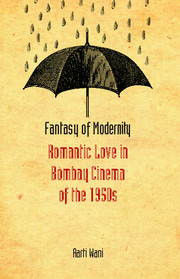Conclusion
Published online by Cambridge University Press: 05 March 2016
Summary
In his art work essay, reflecting on the nature of our relation to cinema, Benjamin (2002, p. 117) famously observed,
Our bars and city streets, our offices and furnished rooms, our railroad stations and our factories seemed to close relentlessly on us. Then came film and exploded this prison-world with the dynamite of a split second, so that now we can set off calmly on journeys of adventure among its far-flung debris.
The contradiction at the heart of Benjamin's imagination is provocative. Film as an escape from the claustrophobia of the lived spaces of the city, only, to journey forth amidst its debris? Indeed, there is no escaping urban modernity and its intimate relation with cinema. However, Benjamin's context was the West. The ‘prison-world’ that the audiences of the 1950s Bombay film sought to escape or at least negotiate, I have tried to demonstrate, was made of different material, new and old, a combination of feudal values, patriarchy, elite fears of cultural contamination, chauvinist pride in ideas of ‘tradition’ and nationalism.
Engaging with the cinema culture of the 1950s and reading its critical discourse, it is difficult not to notice the ubiquity of romantic love in the one and the near absence of it in the other; a scholarly disregard matching the indifference and even hostility towards romance on the street and in the public realm. Of course, love has been and is a major cinematic trope at all times, not only in the 1950s. However, as I have tried to elucidate, the 1950s investment in it was intense and special. If romantic love finds a degree of acceptance today in some quarters, might not one suggest that films play a pedagogic role in producing its cultural common sense and that the 1950s film culture was pivotal in initiating its discourse? If the thematic, visual, lyrical and performative immersion in romance was spectacular in 1950s cinema, the cultural and material context before and immediately after independence was conducive for its configuration via three distinct but interlinked sites – that of the city, the song and stardom.
- Type
- Chapter
- Information
- Fantasy of ModernityRomantic Love in Bombay Cinema of the 1950s, pp. 184 - 197Publisher: Cambridge University PressPrint publication year: 2016



